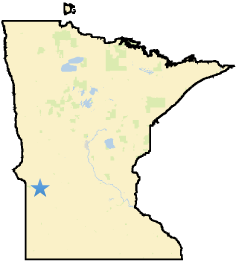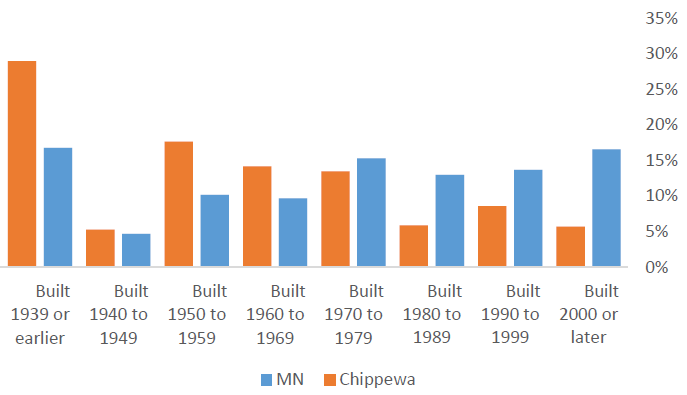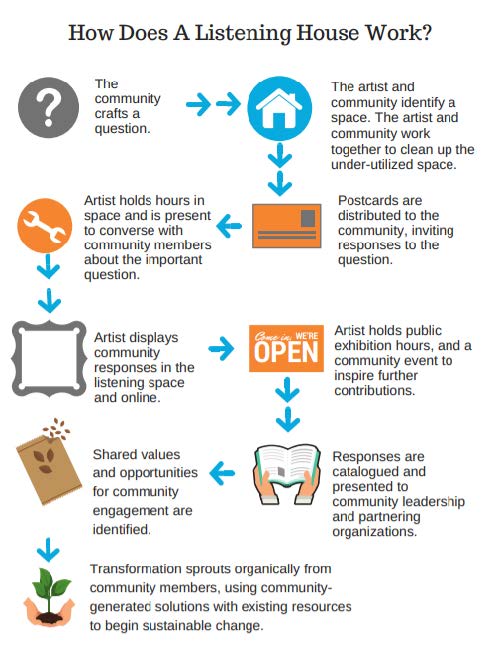Artists seek grassroots solutions to housing issues
Core housing issues addressed
- Housing stock quality
- Housing affordability
Housing challenges
Milan, Minnesota (population 369) is a small community in western Minnesota’s Chippewa County. A third of the town’s occupied housing was built before 1939, a proportion two times greater than the state of Minnesota. Similar to other agricultural communities in western Minnesota, Milan’s old housing stock is both an asset and a liability. While early 20th century homes give the community charm and character, their maintenance and renovation costs can deter potential new residents and investors.
Milan is an active community with a history of grassroots initiatives. It is also home to the Milan Village Arts School and a strong arts community. In keeping with the town’s creative roots, a group of artists sponsored by the Southwest Minnesota Housing Partnership and an ArtPlace CDI grant used a “listening house” process to engage the community on the issue of housing stock quality and vacancies. Rather than having a typical facilitated community meeting with sticky dots and flipcharts, Milan invited all residents and visitors to gather in an art gallery set up in a vacant house. Here, participants developed ideas to address the city’s housing challenge.
Community profile
Chippewa County compared to Minnesota (Source:
2016 American Community Survey, US Census)
According to the 2010 U.S. Census (the most available data), Milan has a population of 369. The Census also estimated that 21 percent of the town’s population was Pacific Islander in 2010, although current estimates stand at about half (Koumpilova, 2016). Since 2000, Micronesians have been migrating to the community. Their presence is a defining characteristic of the town.
Milan is situated in Chippewa County, where the housing stock is significantly older than that of Minnesota (Figure 2). Nearly 30 percent of the housing stock in the county was built before 1939, and an even greater proportion was built during the 1950s and 1960s. According to the Minnesota Housing Partnership’s 2017 profile of Chippewa County, 18 percent of households are cost burdened, paying more than 30 percent of their income for housing.
Housing success story
community engagement (Source: ArtPlace and
Southwest Minnesota Housing Partnership)
Milan’s listening house was a housing engagement process. The project began when four artists transformed a vacant house into an art gallery. They then invited community members (via a postcard) to participate in a conversation on the topic of “What does home mean to you?” The team also invited participation through an introductory YouTube video, Facebook page, and website. The idea behind the listening house concept is to use open-ended questions that bring the community to a shared understanding of the issue and identify creative grassroots solutions.
Aside from activities at the listening house itself, the artists also engaged in one-on-one conversations at community gathering places, such as the town café. They also hosted a community meal dubbed the “Healthy Homes Picnic.” At the event, families were encouraged to not only share their thoughts about community housing challenges but also sign up for housing assessments. The assessments were offered through the Southwest Minnesota Housing Partnership, one of the sponsors of the picnic. This group event and other one-on-one conversations regarding housing helped identify a shared understanding of the town’s housing issues and developed relationships between residents.
Programs and financial resources
This project was co-sponsored by ArtPlace and the Southwest Minnesota Housing Partnership. Funds from these two sponsors covered the home’s $25 per month rent and the time of the four artists who developed the space and managed the initiative.
Who can you follow-up with to learn more or to clarify housing project details?
Kristi Fernholz, senior planner, Upper Minnesota Valley Regional Development Commission
Phone: 320-289-1981 ext. 106 | Email address: kristi.fernholz@umvrdc.org
- Source documents from the Upper Minnesota Valley Regional Development Commission.
- Interview with Kristi Fernholz, Upper Minnesota Valley Regional Development Commission.
- Minnesota Housing Partnership. 2017 County Housing Profile Chippewa County.
- Koumpilova, M. (2016, September 16). In tiny Milan, Minn., a town full of Micronesians weighs the future. Star Tribune.
- U.S. Census Bureau. (2016). American community survey demographic and housing characteristics.
- U.S. Census Bureau. (2010). Profile of general population and housing characteristics.
About the MN Rural Housing study
Small rural communities in Minnesota face persistent housing challenges. In 2017, the state’s regional development organizations (RDOs) identified housing as a top learning focus and called for the creation of case studies that highlight creative solutions to persistent housing issues confronting our smaller communities. This project is a collaboration between the Extension Department of Community Development and the Center for Small Towns.
Reviewed in 2018




